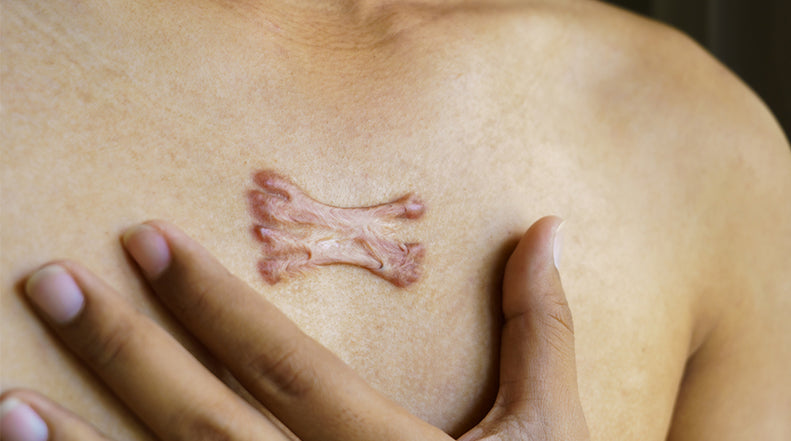The Role of Collagen in Scar Formation

Have you ever wondered why some scars look different than others? Why do some fade over time and some remain on your skin for years? And why do some scars become raised and lumpy while others become sunken and pitted? If you’ve ever pondered these questions, you aren’t alone. Scar formation is a complex process that is not yet fully understood by scientists and researchers. However, it is known that scar formation is dependent on a variety of factors, such as age, ethnicity, and the severity of the injury. One of the main factors that plays a role in the appearance of a scar is collagen, the most abundant protein in the human body. In order to gain a better understanding of why some scars look different than others, keep reading to learn about the role of collagen in scar formation.
WHAT IS COLLAGEN?
As a structural protein, collagen can be thought of as a building block that supports many tissues and structures throughout the body. Collagen can be found in bones, cartilage, tendons, ligaments, and skin, as well as many other tissues and organs. In fact, collagen makes up 25-35% of the body’s entire protein content. Scientists have identified 29 different types of collagen in the human body. However, types 1 through 5 make up 90% of the body’s collagen, with type 1 being the most abundant.
COLLAGEN’S ROLE IN SCAR FORMATION
Scarring is the body’s response to trauma and is a part of the natural healing process. Wound healing is a complex process that involves four main phases: hemostasis, inflammation, proliferation, and tissue remodeling. Collagen is mainly involved during the final two phases of wound healing, which is also when scar tissue begins forming over the wound. Type I and type III are the primary types of collagen that make up scar tissue.
During the proliferative phase of wound healing, cells surrounding the injured skin begin multiplying rapidly. Within the wound bed, cells called fibroblasts produce new collagen in order to start reconstructing the skin’s extracellular matrix (ECM). As the wound transitions into the tissue remodeling phase, the role of collagen is to control the tissue architecture and restore strength to the damaged skin. However, the collagen of scar tissue is different than that of healthy skin: instead of following the sturdier basketweave formation that is found in normal tissue, the collagen cross-links and forms a pronounced alignment in a single direction.
ABNORMAL SCARRING DUE TO COLLAGEN DEGRADATION
Atrophic scars are a type of abnormal scar formation that manifests as a pitted, sunken recess in the skin. Acne scars and pockmarks are examples of sunken scars. According to a publication in the Journal of Clinical and Aesthetic Dermatology, one of the causes of atrophic scarring is degradation of collagen fibers and subcutaneous fat. Unfortunately, there are no topical treatments that can effectively raise sunken scars. It is best to treat resolving atrophic scars early before they sink, while they are still red.
ABNORMAL SCARRING DUE TO EXCESS COLLAGEN
Have you ever heard the saying about having too much of a good thing? Well, that saying definitely applies to the role of collagen in scar formation. As mentioned above, collagen is critical to proper wound healing. However, when the body produces too much collagen a raised, discolored scar can result. These scars can be classified as either hypertrophic scars or keloids. The key feature that distinguishes these two types of scars is that keloids grow past the scar boundary, while hypertrophic scars are confined within the original area of injury. Furthermore, keloids can continue to grow if left untreated.
TO SUM IT UP
It’s clear that the role of collagen in scar formation is important and is also the reason why some scars appear different than others. Too little collagen will result in a sunken atrophic scar and too much collagen will result in a raised keloid or hypertrophic scar. Luckily, there is a way to prevent excess production of collagen during wound healing. Enter silicone gel.
Silicone gel has been used for over three decades in the management of scars due to its proven safety and efficacy. While silicone gel works to heal scars through several mechanisms, one way it works is by providing the scar with adequate hydration. This is important because when a scar becomes dehydrated, the surrounding cells are stimulated to produce more collagen to compensate. Thus, applying a topical silicone gel or silicone gel sheeting to a scar can help prevent abnormal scar formation due to excess collagen.
If you’re curious where to find silicone gel products for your scar, look no further. NewGel+ offers the widest variety of silicone scar treatment products available, ranging from strips, sheets, shapes, and two tube sizes of topical silicone gel. Browse these products now to find the perfect product to soften, flatten, and fade your scar!




Comments